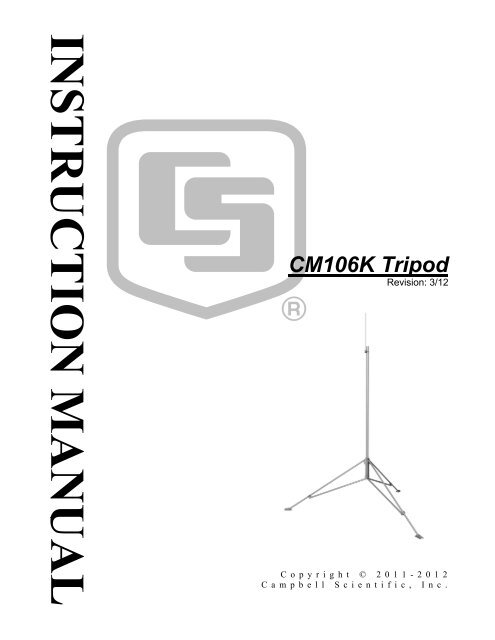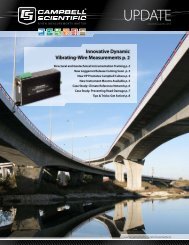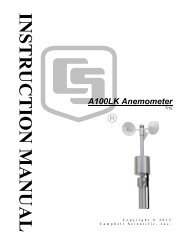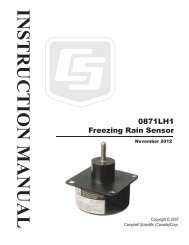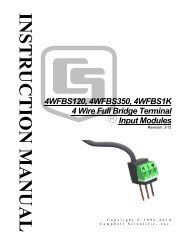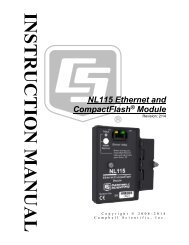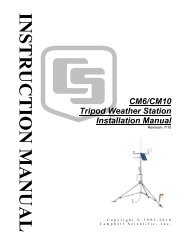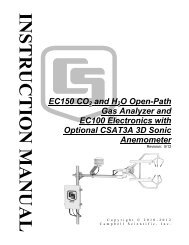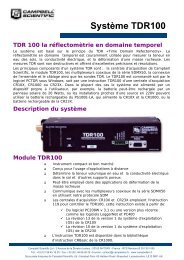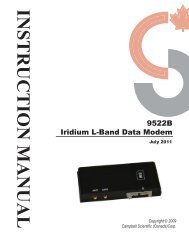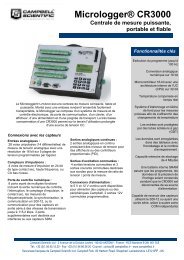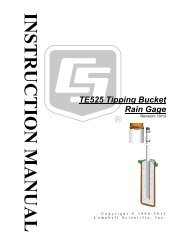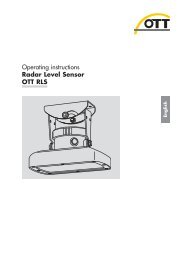CM106K Tripod - Campbell Scientific
CM106K Tripod - Campbell Scientific
CM106K Tripod - Campbell Scientific
You also want an ePaper? Increase the reach of your titles
YUMPU automatically turns print PDFs into web optimized ePapers that Google loves.
Warranty“PRODUCTS MANUFACTURED BY CAMPBELL SCIENTIFIC, INC. arewarranted by <strong>Campbell</strong> <strong>Scientific</strong>, Inc. (“<strong>Campbell</strong>”) to be free from defects inmaterials and workmanship under normal use and service for twelve (12)months from date of shipment unless otherwise specified in the corresponding<strong>Campbell</strong> pricelist or product manual. Products not manufactured, but that arere-sold by <strong>Campbell</strong>, are warranted only to the limits extended by the originalmanufacturer. Batteries, fine-wire thermocouples, desiccant, and otherconsumables have no warranty. <strong>Campbell</strong>'s obligation under this warranty islimited to repairing or replacing (at <strong>Campbell</strong>'s option) defective products,which shall be the sole and exclusive remedy under this warranty. Thecustomer shall assume all costs of removing, reinstalling, and shippingdefective products to <strong>Campbell</strong>. <strong>Campbell</strong> will return such products by surfacecarrier prepaid within the continental United States of America. To all otherlocations, <strong>Campbell</strong> will return such products best way CIP (Port of Entry)INCOTERM® 2010, prepaid. This warranty shall not apply to any productswhich have been subjected to modification, misuse, neglect, improper service,accidents of nature, or shipping damage. This warranty is in lieu of all otherwarranties, expressed or implied. The warranty for installation servicesperformed by <strong>Campbell</strong> such as programming to customer specifications,electrical connections to products manufactured by <strong>Campbell</strong>, and productspecific training, is part of <strong>Campbell</strong>’s product warranty. CAMPBELLEXPRESSLY DISCLAIMS AND EXCLUDES ANY IMPLIEDWARRANTIES OF MERCHANTABILITY OR FITNESS FOR APARTICULAR PURPOSE. <strong>Campbell</strong> is not liable for any special, indirect,incidental, and/or consequential damages.”
AssistanceProducts may not be returned without prior authorization. The followingcontact information is for US and international customers residing in countriesserved by <strong>Campbell</strong> <strong>Scientific</strong>, Inc. directly. Affiliate companies handlerepairs for customers within their territories. Please visitwww.campbellsci.com to determine which <strong>Campbell</strong> <strong>Scientific</strong> company servesyour country.To obtain a Returned Materials Authorization (RMA), contact CAMPBELLSCIENTIFIC, INC., phone (435) 227-9000. After an applications engineerdetermines the nature of the problem, an RMA number will be issued. Pleasewrite this number clearly on the outside of the shipping container. <strong>Campbell</strong><strong>Scientific</strong>'s shipping address is:CAMPBELL SCIENTIFIC, INC.RMA#_____815 West 1800 NorthLogan, Utah 84321-1784For all returns, the customer must fill out a "Statement of Product Cleanlinessand Decontamination" form and comply with the requirements specified in it.The form is available from our web site at www.campbellsci.com/repair. Acompleted form must be either emailed to repair@campbellsci.com or faxed to(435) 227-9106. <strong>Campbell</strong> <strong>Scientific</strong> is unable to process any returns until wereceive this form. If the form is not received within three days of productreceipt or is incomplete, the product will be returned to the customer at thecustomer's expense. <strong>Campbell</strong> <strong>Scientific</strong> reserves the right to refuse service onproducts that were exposed to contaminants that may cause health or safetyconcerns for our employees.
<strong>CM106K</strong> Table of ContentsPDF viewers: These page numbers refer to the printed version of this document. Use thePDF reader bookmarks tab for links to specific sections.1. Cautionary Statements................................................11.1 Site Selection ............................................................................................11.2 <strong>Tripod</strong> Mounting.......................................................................................11.3 <strong>Tripod</strong> Installation ....................................................................................12. <strong>Tripod</strong> Installation........................................................22.1 <strong>Tripod</strong> Base Assembly..............................................................................22.1.1 Parts List .........................................................................................22.1.2 Leg Assembly .................................................................................32.2 <strong>Tripod</strong> Base Positioning ...........................................................................62.2.1 Mounting on a Relatively Flat Area................................................72.2.2 Mounting on an Incline...................................................................72.3 Mast ..........................................................................................................82.4 Installing the Optional Guy Kit ................................................................92.5 Staking the <strong>Tripod</strong> Feet ..........................................................................112.6 <strong>Tripod</strong> Grounding...................................................................................122.7 Crossarm Attachment .............................................................................142.8 Enclosure Attachment.............................................................................142.8.1 Enclosure Mounting to <strong>Tripod</strong> Mast.............................................142.8.2 Enclosure Mounting to <strong>Tripod</strong> Leg...............................................153. General .......................................................................174. Specifications ............................................................185. Tools List (for tripod, mast, enclosures, andcrossarms) ...............................................................186. <strong>Tripod</strong> Components...................................................197. Mounting Brackets ....................................................197.1 CM210 Crossarm Mounting Kit.............................................................197.2 CM216 Mast Mounting Kit ....................................................................207.3 CM220 Right Angle Mounting Kit.........................................................217.4 CM225 and 18098 Pyranometer Mounting Stand ..................................227.5 CM230 Adjustable Angle Mounting Kit ................................................237.6 CM235 Magnetic Mounting Stand .........................................................247.7 RM Young Gill Radiation Shields..........................................................25i
<strong>CM106K</strong> Table of ContentsFigures2-1. <strong>Tripod</strong> component dimensions ............................................................... 32-2. Comparison of one leg pointing downhill (right) versus two legspointing downhill ................................................................................ 72-3. Guy collar ............................................................................................... 92-4. Anchor attachment................................................................................ 102-5. Staking the tripod feet........................................................................... 112-6. Ground rod and clamp .......................................................................... 122-7. Lightning rod and tripod grounding lug ............................................... 132-8. CM204 Crossarm.................................................................................. 142-9. Enclosure with the –MM Bracket......................................................... 152-10. Enclosure with the –LM Bracket........................................................ 163-1. Typical tripod-based weather station.................................................... 177-1. CM210 Crossarm Mounting Kit (shown with user-supplied pipe) ...... 197-2. CM216 Mast Mounting Kit .................................................................. 207-3. CM220 Right Angle Mounting Kit....................................................... 217-4. CM225 Pyranometer Mounting Stand.................................................. 227-5. CM230 Adjustable Angle Mounting Kit .............................................. 237-6. CM235 Magnetic Mounting Stand ....................................................... 247-7. RM Young Gill Radiation Shield ......................................................... 25ii
<strong>CM106K</strong> <strong>Tripod</strong>1. Cautionary Statements1.1 Site Selection1.2 <strong>Tripod</strong> Mounting1.3 <strong>Tripod</strong> Installation• Select a safe site to install the tripod.• The distance between any power lines and the installation site should be atleast one and one-half times the height of the tripod. Make the distanceeven greater, if at all possible. Since all overhead power lines looksomewhat alike, consider them all dangerous and stay well away fromthem.• If you have power lines or buried utilities in the area, call your local utilityproviders for assistance.• NEVER work alone; always have someone near who can summon help.• Certain clothing may provide a degree of safety, but don't depend on it foryour life (rubber boots or shoes, industrial rubber gloves and a long sleeveshirt or jacket).• Check weather conditions. Be sure that it hasn't rained recently and thatthe ground is not wet or muddy. Make sure that rain or thunderstorms arenot predicted for the day you decide to install the tripod.• The wind can blow the tripod into a nearby power line. Don't install orremove tripods in moderate or heavy winds.• If you need to use a ladder, make sure it is made of non-conductive (nonmetallic)material. (This is a safety rule that you should follow wheneveryou're working with electrical equipment.)• If possible, have someone present who has been trained in electric shockfirst aid.• Properly assemble the tripod according to instructions (do this where thetripod is to be put up).• Once the tripod is up in full vertical position, securely fasten it to theground using ground spikes. For situations where soil structure isquestionable or the tripod may experience high wind loads, concretefootings for the tripod feet and guy anchors should be considered.• Ground the tripod according to the National Electrical Code.1
<strong>CM106K</strong> <strong>Tripod</strong>2. <strong>Tripod</strong> Installation2.1 <strong>Tripod</strong> Base Assembly2.1.1 Parts ListPart # Description Qty10838 <strong>Tripod</strong> Foot 327392 <strong>CM106K</strong> Body 319308 Spacer 64366 5/16” Lock Washer 619175 5/16-18x2.25” Bolt 618126 5/16-18 Bronze Nut 619031 Grounding Clamp 227113 #10-32 x 0.75” Bolt 41201 Clamp Bracket 375 5/16-18 x 0.75” Bolt 3795 ¼-20 Nylock Nut 6794 ¼-20 x 1.75” Bolt 12850 CM10 Lightning Rod 117589 Lightning Rod Clamp Assembly 12
<strong>CM106K</strong> <strong>Tripod</strong>2.1.2 Leg Assembly1. Refer to Figure 2-1 to create the following parts:• Three (3) Leg Braces• Three (3) Legs• One (1) MastLeg Brace (3 required)Leg (3 required)Mast (1 required)Optional for Guy Kit20.00 [50.8 cm]Leg BraceLegMastMaterial3/4 NPS SCH40[DN 20 mm]3/4 NPS SCH40[DN 20 mm]11/2NPSSCH40[DN 40 mm]Wall Thickness0.113”[2.87 mm]0.113”[2.87 mm]0.145”[3.683 mm]Length48.0”[121.9 cm]72.0”[182.9 cm]100.0”[254 cm]QTY331Mast and mast legs must be made of Steel(Minimum yield Strength of 36 ksi [248 MPa])FIGURE 2-1. <strong>Tripod</strong> component dimensions3
<strong>CM106K</strong> <strong>Tripod</strong>2. Using a ¼-20 x 1.75” bolt and ½-20 nylock nut, attach a foot to eachtripod leg (Figure 2-2).Leg1/4-20 x 1.75” Bolt1/4-20 Nylock NutFoot3. Slide a clamp bracket onto each leg. Thread a 5/16-18 x 0.75” bolt into thebracket, leaving the bracket free to move. Attach a leg brace to each clampbracket using a ¼-20 x 1.75” bolt and nylock nut.Leg5/16-18 x 0.75” BoltLeg Brace1/4-20 x 1.75” Bolt1/4-20 Nylock NutClamp Bracket4
<strong>CM106K</strong> <strong>Tripod</strong>4. Pass a 5/16-18 x 2.25” bolt through a mounting hole in one of the tripodbody pieces as shown. Slide a spacer over the bolt. Place a second tripodbody piece over the end of the bolt, followed by a 5/16 lock washer. Handtighten a 5/16-18 bronze nut on the end of the bolt. Repeat this processwith the other five 5/16-18 x 2.25” bolts to assemble the tripod body.Top View<strong>Tripod</strong> BodySpacerSpacer5/16 Lock Washer5/16-18 x 2.25” Bolt5/16-18 Bronze Nut<strong>Tripod</strong> Body5/16 Lock Washer5/16-18 x 2.25” Bolt5/16-18 Bronze NutSpacer5
<strong>CM106K</strong> <strong>Tripod</strong>5. Attach each leg assembly to the tripod body using two ¼-20 x 1.75” boltsand nylock nuts. Attach the two grounding clamps using #10-32 x 0.75”bolts. Do not over-tighten the bolts. The tripod legs and leg braces must beable to pivot.1/4-20 x 1.75” Bolt1/4-20 Nylock NutLegLeg<strong>Tripod</strong> BodyGrounding Clamp#10-32 x 0.75” BoltGrounding Clamp1/4-20 x 1.75” Bolt#10-32 x 0.75” Bolt1/4-20 Nylock NutLeg Brace2.2 <strong>Tripod</strong> Base PositioningWARNING<strong>Tripod</strong> installation near power lines is dangerous. Theminimum safe recommended distance from overheadpower lines is 1½ times the height of the tripod andmast combined. Call your local utility providers tolocate buried utilities prior to installation.The tripod base has three legs, which are individually adjustable, that allow thetripod to be installed over non-level terrain.6
<strong>CM106K</strong> <strong>Tripod</strong>Prepare the area where the tripod will be installed. The tripod requires an areaapproximately 11 ft (3.4 m) in diameter. Natural vegetation and the groundsurface should be disturbed as little as possible, but brush and tall weeds shouldbe removed.Stand the tripod base up on end, and rotate the feet perpendicular to the legs.Each leg has a clamp bracket with a bolt that locks the leg in place whentightened.2.2.1 Mounting on a Relatively Flat AreaLoosen one clamp bracket bolt at a time and extend each leg until the three legsare at the same extension. With the legs extended, orient the tripod so that oneof the legs points South (assuming the instrument enclosure with -MM MastMount bracket will face North). If the instrument enclosure has the -LM LegMount bracket, orient the tripod so that the enclosure will mount to one of thethree leg mount positions on the tripod, facing the desired direction. The tripodis typically plumbed after the mast has been installed, as described in Section2.3.2.2.2 Mounting on an InclineLoosen the bolts on the clamp brackets. With the legs extended, orient thetripod so that one leg points downhill and the other two legs point uphill. Thetripod is more stable with only one leg pointed downhill because the mast iscloser to the center of the footprint (see Figure 2-2). Tighten the bolts on theclamp brackets to lock the legs in place.The tripod is typically plumbed after the mast has been installed, as describedin Section 2.3.[3.4m]Ø132in[3.4m]Ø132inOne Foot DownhillForBetterStabilityGRADEGRADE = 100% * (RISE/RUN) = 100% * tan(angle)FIGURE 2-2. Comparison of one leg pointing downhill (right) versustwo legs pointing downhill7
<strong>CM106K</strong> <strong>Tripod</strong>2.4 Installing the Optional Guy KitPN 27117 CM106 Guy Kit can be ordered separately for areas that experiencehigh wind speeds (Section 4). Install the guy bracket to the mast as shown inFigure 2-3. Attach the three guy wires to the guy collar and slide the collar overthe mast so that the collar butts against the bracket.Guy CollarGuy WireGuy BracketFIGURE 2-3. Guy collarOn the end of each guy line is a case and hardware to attach to the turnbuckles.Unscrew the turnbuckles so that only 1/2 in of thread extends beyond the insideof the turnbuckle body. Attach the case and turnbuckle to secured earth anchorssuch as those shown in Fig 2-4. For best results, secure the earth anchors in theground at the same angle the guy wires will be attached. Loosen the Phillipsscrew, and remove the slack in the guy line by feeding the load end of the guywire through the wedge while pulling up on the dead end. If the load end ofthe guy wire can’t be fed through the case, use a small flat screwdriver to pushthe wedge forward into the case to disengage wedge.After the slack has been removed from the guy lines, tighten the Phillipsscrews and tighten the turnbuckles to tension each guy line to approximately100 lbf [45 kgf].9
<strong>CM106K</strong> <strong>Tripod</strong>Duckbill StyleEarth AnchorAuger StyleEarth AnchorWedgePhillips ScrewFIGURE 2-4. Anchor attachment10
<strong>CM106K</strong> <strong>Tripod</strong>2.5 Staking the <strong>Tripod</strong> FeetFor additional stability, the tripod can be staked to the ground using (3) PN17049 ground spikes, or secured with user-supplied anchors through the holesin the feet. Drive the spike at an angle through the hole in each foot.Spikes may not be adequate depending on soil structure, maximum windspeeds experienced at the site, mast height, or wind load from theinstrumentation. For questionable situations, concrete footings for the tripodfeet and guy anchors should be considered.FIGURE 2-5. Staking the tripod feet11
<strong>CM106K</strong> <strong>Tripod</strong>2.6 <strong>Tripod</strong> GroundingThe tripod must be properly grounded using a user-supplied grounding rod.Place the clamp over the ground rod and drive the rod (close to the center ofthe tripod) using a sledge hammer or fence post driver. Strip 1/2” [12.7 mm]inch of insulation from both ends of a 4 AWG ground wire. Insert one end ofthe ground wire between the clamp and ground rod and tighten the bolt on theclamp. Attach the other end of the ground wire to the lug on the tripod base asshown in Figure 2-6.Ground LugGround WireEnclosure Ground WireEnclosure Ground LugFIGURE 2-6. Ground rod and clampStrip 1/2” [12.7 mm] of insulation from the ends of a 12 AWG wire. Attachone end of the wire to the tripod ground lug, and the other end to the enclosureground lug as shown in Figure 2-6.12
<strong>CM106K</strong> <strong>Tripod</strong>Mount the lightning rod and clamp to the tripod mast with pointed tip up, andnotch at bottom, as shown in Figure 2-7.FIGURE 2-7. Lightning rod and tripod grounding lug13
<strong>CM106K</strong> <strong>Tripod</strong>2.7 Crossarm AttachmentAttach the CM202 (2 ft, 0.6m), CM204 (4 ft, 1.2m), or CM206 (6 ft, 1.8m)crossarm to the tripod mast as shown in Figure 2-8. For wind sensors, thecrossarm should be approximately 103 inches above the ground. Typically thecrossarm is oriented East/West for wind sensors, North/South forpyranometers.CM200 SeriesCrossarm<strong>Tripod</strong> MastFIGURE 2-8. CM204 Crossarm2.8 Enclosure AttachmentThe ENC 10/12, ENC 12/14, ENC 14/16, and ENC 16/18 enclosures can beordered with mounting brackets for the <strong>CM106K</strong> tripod. All enclosure modelscan be mounted to the tripod mast (above the legs) with the –MM Mast Mountbracket option. All enclosure models except the ENC 16/18 can be mounted tothe tripod base and leg with the –LM Leg Mount bracket option.2.8.1 Enclosure Mounting to <strong>Tripod</strong> MastAn enclosure ordered with the –MM bracket has a three-piece top and bottombrackets with a U-bolt for each bracket.Attach an enclosure with the –MM mounting bracket to the tripod mast asfollows:Remove the U-bolts washers and nuts from the brackets.Position the enclosure against the tripod’s mast (North side recommended).Install the U-bolts, flat washers, lock washers, and nuts. Tighten the nuts untilthe lock washers are compressed.14
<strong>CM106K</strong> <strong>Tripod</strong>Route the 14 AWG wire from the grounding lug on the bottom side of theenclosure to the grounding lug on the base of the tripod (Figure 2-6). Strip1/2” [12.7 mm] of insulation from each end of the wire. Insert wire ends intothe grounding lugs and tighten.U-Bolt–MM BracketFIGURE 2-9. Enclosure with the –MM Bracket2.8.2 Enclosure Mounting to <strong>Tripod</strong> LegAn enclosure ordered with the –LM bracket has a bracket on each side of theenclosure, and a U-bolt bracket for securing the enclosure to a tripod leg.Attach an enclosure with the –LM mounting bracket to the tripod base asfollows:Slide the keyhole notch in upper corner of the -LM bracket over the hooklocated on the tripod base as shown in Figure 2-10, and engage the notch in thelower corner of the -LM bracket with the enclosure tab.Remove the washers, nuts and U-bolt from the U-bolt bracket. Install thebracket as shown in Figure 2-10 (bottom) with the U-bolt capturing the tripodleg. Tighten the nuts on the U-bolt until the lock washers are compressed.15
<strong>CM106K</strong> <strong>Tripod</strong>Route the 14 AWG wire from the grounding lug on the bottom side of theenclosure to the grounding lug on the base of the tripod (Figure 2-6). Strip 1/2”of insulation from each end of the wire. Insert wire ends into the groundinglugs and tighten.FIGURE 2-10. Enclosure with the –LM Bracket16
<strong>CM106K</strong> <strong>Tripod</strong>3. GeneralThe <strong>CM106K</strong> is a general purpose tripod that can be used for mountingsensors, solar panels, antennas, and instrument enclosures. The <strong>CM106K</strong> isconstructed from galvanized steel, with individually adjustable legs that allowinstallation over uneven terrain. Height of the mast is 10 ft (3m).The <strong>CM106K</strong> includes the tripod body, feet, brackets, grounding clamps,lightning rod, and mounting hardware. The remaining tripod components areuser-supplied (see Section 2 for part specifications).An optional guy kit is recommended for sites that experience high wind speeds(see Section 4, Allowable Wind Speed Specifications). Instrument enclosurescan be purchased with mounting brackets that attach to either the mast or legsection as shown in Section 2.8.The <strong>CM106K</strong> can be used for a variety of applications. For meteorologicalstations, sensors are mounted to the tripod using mounting brackets appropriatefor the model of sensor. For non-meteorological applications the tripod can beused to mount instrument enclosures, solar panels, junction boxes, or antennas.FIGURE 3-1. Typical tripod-based weather station17
<strong>CM106K</strong> <strong>Tripod</strong>6. <strong>Tripod</strong> Components7. Mounting BracketsThe tripod body is packaged with the lightning rod. The optional guy kit ispackaged separately.Mounting brackets covered in this section have U-bolts that attach to verticaland/or horizontal pipes with the following ranges of outside diameters:inches mm Nominal Pipe Size (inches)1.5” U-bolt 1.0 – 1.5 25.4 – 38.1 ¾ – 12” U-bolt 1.3 – 2.1 33.0 – 53.3 1 – 1 ½2” U-boltwith plastic V-block1.0 – 2.1 25.4 – 53.3 ¾ – 1 ½Some of the brackets (e.g. the CM210) include 1.5” and 2” U-bolts to extendthe range of pipe diameters that the bracket can accommodate. Brackets withholes for a 1.5” U-bolt will accept a user-supplied 1.75” U-bolt.7.1 CM210 Crossarm Mounting KitCM200 series crossarms include a CM210 bracket as shown in Figure 7-1.The CM210 can be ordered separately to attach a user-supplied pipe (1.0 –1.5” OD) to a mast or tower leg (1.0 – 2.1” OD), or to attach a crossarm to twotower legs.CM210FIGURE 7-1. CM210 Crossarm Mounting Kit (shown with user-suppliedpipe)19
<strong>CM106K</strong> <strong>Tripod</strong>7.2 CM216 Mast Mounting KitThe CM216 attaches to the top of the mast, and provides a 3/4” or 1” mountingpipe (1.05” or 1.32” OD) that extends 4” above the mast, as shown in Figure7-2.CM216FIGURE 7-2. CM216 Mast Mounting Kit20
<strong>CM106K</strong> <strong>Tripod</strong>7.3 CM220 Right Angle Mounting KitThe CM220 attaches a vertical pipe (1.0 – 1.5” OD) to the CM200 seriescrossarms or horizontal pipe (1.0 – 1.5” OD) as shown in Figure 7-3.CM220CM220FIGURE 7-3. CM220 Right Angle Mounting Kit21
<strong>CM106K</strong> <strong>Tripod</strong>7.4 CM225 and 18098 Pyranometer Mounting StandThe CM225 is used to attach a pyranometer or quantum sensor to a horizontalpipe (1.0 to 2.1” OD) or vertical pole (1.0 to 2.1” OD).The LI200X pyranometer and LI190SB quantum sensor mount to the CM225via the LI200S leveling base (see Figure 7-4). The CS300 pyranometer mountsto the CM225 via the 18356 leveling base. The CMP3 and LP02 pyranometersinclude their own bubble level and leveling screws allowing them to mountdirectly to the CM225.The 18098 provides a larger surface for mounting a user-supplied Eppleypyranometer.CM225LI2003SLI200X PyranometerCM225FIGURE 7-4. CM225 Pyranometer Mounting Stand22
<strong>CM106K</strong> <strong>Tripod</strong>7.5 CM230 Adjustable Angle Mounting KitThe CM230 mounts an antenna (1.0 – 1.5” OD) to a mast or vertical pipe(1.3 – 2.1” OD) as shown in Figure 7-5. The bracket allows the antenna to beadjusted for different angles.CM230FIGURE 7-5. CM230 Adjustable Angle Mounting Kit23
<strong>CM106K</strong> <strong>Tripod</strong>7.6 CM235 Magnetic Mounting StandThe CM235 provides a 3.5” (8.8 cm) square platform for mounting magneticbase antennas. The CM235 attaches to horizontal or vertical pipes (1.0 –2.1” OD) as shown in Figure 7-6.FIGURE 7-6. CM235 Magnetic Mounting Stand24
<strong>CM106K</strong> <strong>Tripod</strong>7.7 RM Young Gill Radiation ShieldsRM Young Gill Radiation Shields are used to house and attach temperature andrelative humidity sensors to the tripod mast (1.0 – 2.1” OD) or crossarm asshown in Figure 7-7. Radiation shields ship with the U-bolt configured forattachment to a vertical pipe. To attach the radiation shield to a horizontalpipe, the U-bolt and plastic V-block must be moved to the other set of holes.FIGURE 7-7. RM Young Gill Radiation Shield25
<strong>CM106K</strong> <strong>Tripod</strong>26
<strong>Campbell</strong> <strong>Scientific</strong> Companies<strong>Campbell</strong> <strong>Scientific</strong>, Inc. (CSI)815 West 1800 NorthLogan, Utah 84321UNITED STATESwww.campbellsci.com • info@campbellsci.com<strong>Campbell</strong> <strong>Scientific</strong> Africa Pty. Ltd. (CSAf)PO Box 2450Somerset West 7129SOUTH AFRICAwww.csafrica.co.za • cleroux@csafrica.co.za<strong>Campbell</strong> <strong>Scientific</strong> Australia Pty. Ltd. (CSA)PO Box 8108Garbutt Post Shop QLD 4814AUSTRALIAwww.campbellsci.com.au • info@campbellsci.com.au<strong>Campbell</strong> <strong>Scientific</strong> do Brazil Ltda. (CSB)Rua Luisa Crapsi Orsi, 15 ButantãCEP: 005543-000 São Paulo SP BRAZILwww.campbellsci.com.br • suporte@campbellsci.com.br<strong>Campbell</strong> <strong>Scientific</strong> Canada Corp. (CSC)11564 - 149th Street NWEdmonton, Alberta T5M 1W7CANADAwww.campbellsci.ca • dataloggers@campbellsci.ca<strong>Campbell</strong> <strong>Scientific</strong> Centro Caribe S.A. (CSCC)300 N Cementerio, Edificio BrellerSanto Domingo, Heredia 40305COSTA RICAwww.campbellsci.cc • info@campbellsci.cc<strong>Campbell</strong> <strong>Scientific</strong> Ltd. (CSL)<strong>Campbell</strong> Park80 Hathern RoadShepshed, Loughborough LE12 9GXUNITED KINGDOMwww.campbellsci.co.uk • sales@campbellsci.co.uk<strong>Campbell</strong> <strong>Scientific</strong> Ltd. (France)3 Avenue de la Division Leclerc92160 ANTONYFRANCEwww.campbellsci.fr • info@campbellsci.fr<strong>Campbell</strong> <strong>Scientific</strong> Spain, S. L.Avda. Pompeu Fabra 7-9, local 108024 BarcelonaSPAINwww.campbellsci.es • info@campbellsci.esPlease visit www.campbellsci.com to obtain contact information for your local US or International representative.


